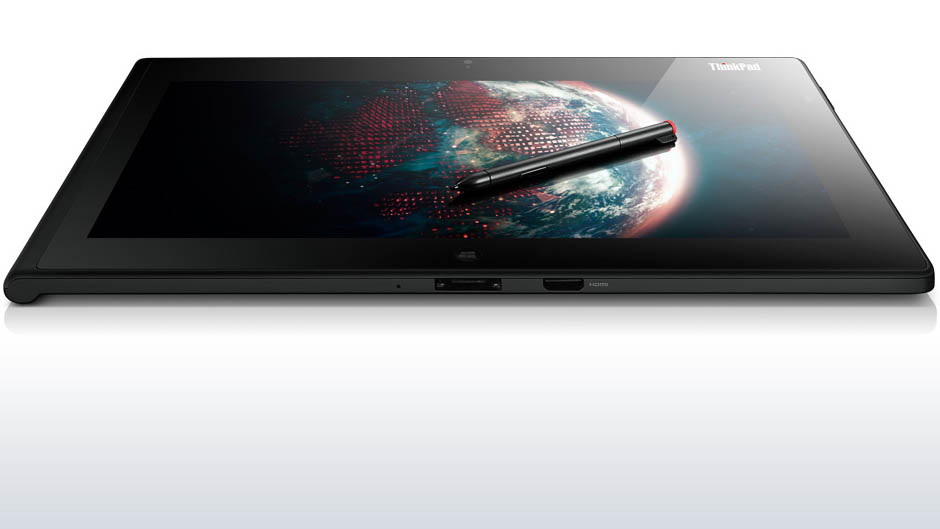Lenovo Thinkpad Tablet 2 and my unsuccessful attempt to install Linux
I recently bought a Lenovo Thinkpad Tablet 2 . While Lenovo's first Thinkpad was based on the ARM architecture, this device uses an Intel Atom Z2760 processor . It comes preinstalled with 32-bit Windows 8.

The official image from Lenovo's website
I will not describe in detail the characteristics here. Anyone interested can easily find them on the net. In general, the device is pretty decent ( review on Engadget and Habrahabr ). However, some of its parameters formed an unusual combination, which led to the fact that I could not install any of the GNU / Linux variants on it. Details below.
Before making a purchase, I first sat down in search engines to study the compatibility issue of hardware and Linux. There was no sign of trouble: the x86 processor, supported by WiFi, the touch screen, video is not the most ordinary, but it seems to start, which is turned off just in case, UEFI Secure Boot. However, in the search engine results there were no (or I did not pay attention to) messages about a successful OS change to something other than Windows.
Okay, we don’t get used to it. I bought it. Included. Works. Turned off. He began to download images of the installers Debian, OpenSuse, Ubuntu and upload it to a USB flash drive. Do not start. I began to think and read the Internet more carefully, paying closer attention already to feedback on failures. As a result, the following picture of things was formed:
The latter circumstance was the main reason for my failure, and here's why:
For 64-bit processors, everything is there. For 32-bit in Legacy mode with the subsequent switch to UEFI - is. But immediately UEFI and only 32 bits - no. The maximum that I managed to achieve was the appearance of the GRUB screen with a half-working keyboard, which, when I tried to load Debian, crashed immediately.
I am writing this post in order to warn others about the problems of this, as it turned out, exotic device. On the other hand, the same Atom is used in other Windows 8 tablets, and the problems are identical there.
mjg59.dreamwidth.org/26734.html - Don't ship 32-bit UEFI firmware on x86
bugs.launchpad.net/ubuntu-cdimage/+bug/1025555 - Ubuntu i386 images are not compatible with 32-bit UEFI computers
ubuntuforums. org / showthread.php? t = 2169631 - similar problems on Asus VivoTab tf810c.
cdimage.debian.org/cdimage/unofficial/efi-development/upload5 - the same image on which I saw Grub, and then things did not go further.

The official image from Lenovo's website
I will not describe in detail the characteristics here. Anyone interested can easily find them on the net. In general, the device is pretty decent ( review on Engadget and Habrahabr ). However, some of its parameters formed an unusual combination, which led to the fact that I could not install any of the GNU / Linux variants on it. Details below.
Before making a purchase, I first sat down in search engines to study the compatibility issue of hardware and Linux. There was no sign of trouble: the x86 processor, supported by WiFi, the touch screen, video is not the most ordinary, but it seems to start, which is turned off just in case, UEFI Secure Boot. However, in the search engine results there were no (or I did not pay attention to) messages about a successful OS change to something other than Windows.
Okay, we don’t get used to it. I bought it. Included. Works. Turned off. He began to download images of the installers Debian, OpenSuse, Ubuntu and upload it to a USB flash drive. Do not start. I began to think and read the Internet more carefully, paying closer attention already to feedback on failures. As a result, the following picture of things was formed:
- The Atom tablet used in the tablet only supports 32-bit protected mode.
- Used by UEFI, Secure Boot is easy to disable
- No Legacy boot mode
The latter circumstance was the main reason for my failure, and here's why:
- There is no Linux installer, no distribution that supports installation in UEFI mode on a 32-bit processor.
For 64-bit processors, everything is there. For 32-bit in Legacy mode with the subsequent switch to UEFI - is. But immediately UEFI and only 32 bits - no. The maximum that I managed to achieve was the appearance of the GRUB screen with a half-working keyboard, which, when I tried to load Debian, crashed immediately.
I am writing this post in order to warn others about the problems of this, as it turned out, exotic device. On the other hand, the same Atom is used in other Windows 8 tablets, and the problems are identical there.
Additional Information
mjg59.dreamwidth.org/26734.html - Don't ship 32-bit UEFI firmware on x86
bugs.launchpad.net/ubuntu-cdimage/+bug/1025555 - Ubuntu i386 images are not compatible with 32-bit UEFI computers
ubuntuforums. org / showthread.php? t = 2169631 - similar problems on Asus VivoTab tf810c.
cdimage.debian.org/cdimage/unofficial/efi-development/upload5 - the same image on which I saw Grub, and then things did not go further.
